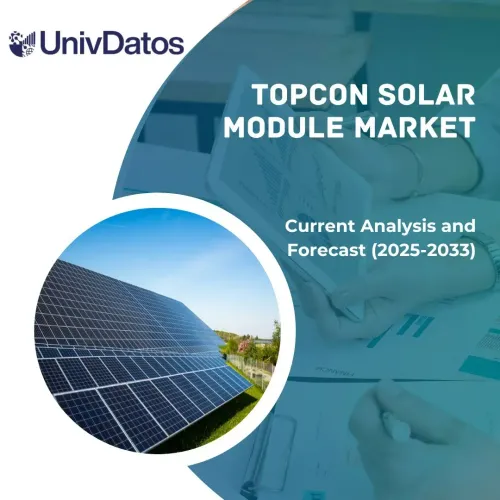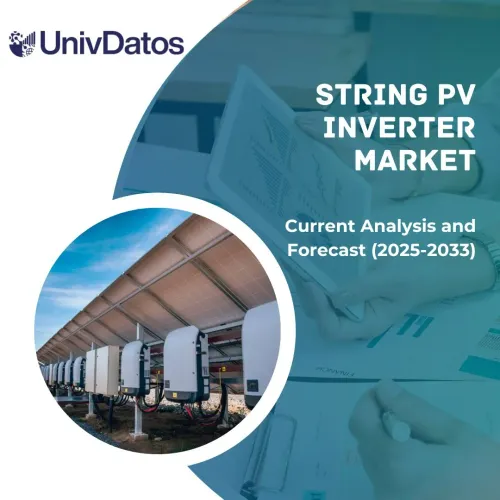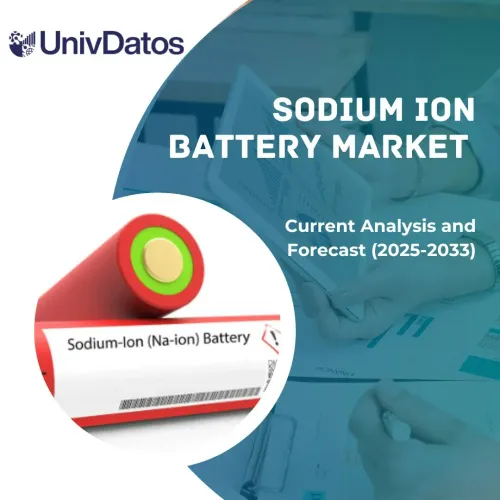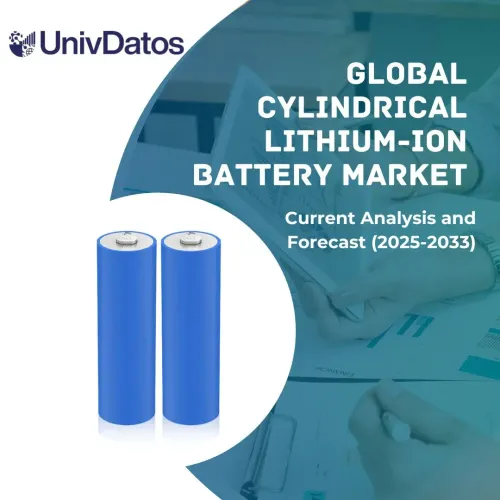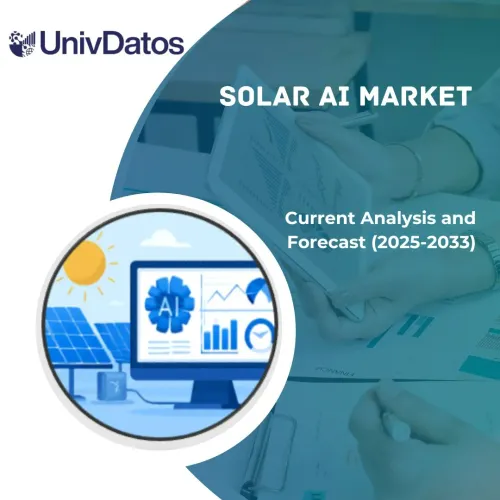- Home
- About Us
- Industry
- Services
- Reading
- Contact Us
Oil and Gas Accumulator Market: Current Analysis and Forecast (2022-2028)
Emphasis on Type (Piston Accumulator, Bladder Accumulator, and Diaphragm Accumulator); Location of Deployment (Onshore and Offshore); Application (Mud Pump, Blow-out Preventor, Drilling Rigs, and others); and Region/Country
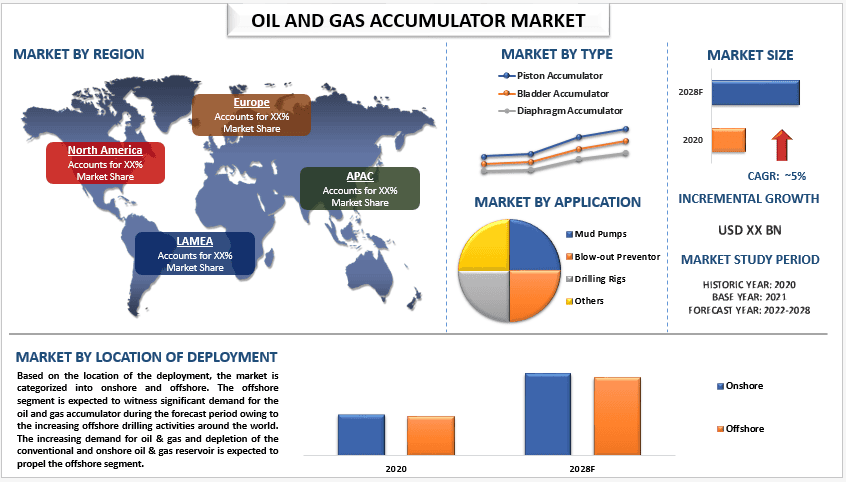
Global Oil & Gas Accumulator Market is expected to grow at a significant rate of around 5% during the forecast period 2022-2028. The oil and gas accumulator is defined as hydro-pneumatic equipment and is used to store non-compressible fluid under extreme conditions. Additionally, the oil and gas accumulator is used to monitor, control, and seal oil wells from high pressure in order to prevent the release of crude oil from the oil wells. The oil and gas accumulator is also able to deal with extreme underwater pressure and uncontrol flow of the reservoirs. In recent times, the oil and gas accumulator witnessed significant growth in demand due to the surging demand from the transport segment which subsequently propel the demand for the oil and gas and therefore increase the demand for the oil and gas accumulator. Moreover, the increasing demand for oil and gas for transportation, automotive, and industrial heating among many other are expected to propel the market for the oil and gas accumulator. For instance, according to the International Energy Agency, the global consumption of oil was rise by 5.4 million barrels per day in the year 2021 and is expected to increase by additional 3.3 million barrels in the year 2022.
Bosch Rexroth AG, Eaton Corporation PLC, Nippon Accumulator Co Ltd, NOK Corporation, HYDAC INTERNATIONAL GmbH, Freudenberg Group, PARKER HANNIFIN CORP, Pressure Technologies, Hydroll, and SCI Sharp Controls, Inc.are some of the key players in the market. Several M&As along with partnerships have been undertaken by these players to facilitate customers with hi-tech and innovative products/technologies.
Insights Presented in the Report
“Amongst type, bladder category to witness higher CAGR during the forecast period”
Based on type, the market is segmented into piston accumulator, bladder accumulation, and diaphragm accumulator. The bladder segment is expected to register significant market growth during the forecast period due to the lower inertia with the quick response which makes it suitable for pulsation dampening. In a bladder accumulator, the hydraulic fluid compressed the nitrogen-filled bladder to generate the pressure. Also, the bladder system offers significant features such as simple installation, easy charging, quick response time, easy maintenance, and compensation for pressure response among other features. Furthermore, the bladder accumulator is made up of a high-strength steel shell that allowed it to operate smoothly under extreme conditions such as high temperature and high pressure
“Amongst location of deployment, the offshore segment to hold a significant share in the market in 2020”
Based on the location of the deployment, the market is categorized into onshore and offshore. The offshore segment is expected to witness significant demand for the oil and gas accumulator during the forecast period owing to the increasing offshore drilling activities around the world. Offshore oil and gas exploration requires special attention and includes exploration and drilling, oil production, blowout prevention, and pre-charge maintenance among others. The increasing demand for oil & gas and depletion of the conventional and onshore oil & gas reservoir is expected to propel the offshore segment. Also, exploration in the Gulf of Mexico and other locations is expected to contribute significantly to the offshore oil and gas accumulator market. For instance, the Gulf of Mexico accounted nearly 15 percent of the total US crude oil production and 2 percent of total US dry natural gas production for the year 2020.
“North America to hold a significant share in the market”
In 2020, North America held a significant share of the global oil and gas accumulator market. This is mainly due to the increasing drilling activities in the region. Also, the increasing shale oil and gas oil coupled with technological advancements such as the implementation of AI, ML, big data, hydraulic fracking technology, and digitalization of the oil wells in the region are propelling the demand for the oil and gas accumulator in the region. According to a leading research firm, the USA Permian Basin condensate & crude oil capacity is 5,055 mbd, and natural gas capacity is approximately 19,891 mmcfd in the year 2022. The drilling and exploration activities in the Permian Basin support the growth of the oil and gas accumulator in the region. Additionally, the increasing number of new oil and gas fields in the region and growing investment in oil fields are expected to create the demand for oil and gas accumulator equipment. For instance, 88 Energy an Australian oil company discovered the new oil field NPR-A or Merlin-1 in Alaska with the capacity of 3.4 billion barrels of oil equivalent. Furthermore, the supportive government initiative in the region also supports exploration activities and subsequently grows the demand for oil and gas accumulators in the region. For instance, the permission to use diesel oil for hydraulic fracturing and allowance of the underground injection of waste fluids extracted from oil and gas well as per the defined standard among other.
Reasons to buy this report:
- The study includes market sizing and forecasting analysis validated by authenticated key industry experts.
- The report presents a quick review of overall industry performance at one glance.
- The report covers an in-depth analysis of prominent industry peers with a primary focus on key business financials, product portfolio, expansion strategies, and recent developments.
- Detailed examination of drivers, restraints, key trends, and opportunities prevailing in the industry.
- The study comprehensively covers the market across different segments.
- Deep dive regional level analysis of the industry.
Customization Options:
The global oil & gas accumulator market can further be customized as per the requirement or any other market segment. Besides this, UMI understands that you may have your own business needs, hence feel free to connect with us to get a report that completely suits your requirements.
Table of Content
Research Methodology for the Oil & Gas Accumulator Market Analysis (2022-2028)
Analyzing the historical market, estimating the current market, and forecasting the future market of the global oil & gas accumulator market were the three major steps undertaken to create and analyze the adoption of oil & gas accumulators in major regions globally. Exhaustive secondary research was conducted to collect the historical market numbers and estimate the current market size. Secondly, to validate these insights, numerous findings and assumptions were taken into consideration. Moreover, exhaustive primary interviews were also conducted, with industry experts across the value chain of the global oil & gas accumulator market. Post assumption and validation of market numbers through primary interviews, we employed a top-down/bottom-up approach to forecasting the complete market size. Thereafter, market breakdown and data triangulation methods were adopted to estimate and analyze the market size of segments and sub-segments of the industry pertains to. Detailed methodology is explained below:
Analysis of Historical Market Size
Step 1: In-Depth Study of Secondary Sources:
Detail secondary study was conducted to obtain the historical market size of the oil & gas accumulator market through company internal sources such as annual reports & financial statements, performance presentations, press releases, etc., and external sources including journals, news & articles, government publications, competitor publications, sector reports, third-party database, and other credible publications.
Step 2: Market Segmentation:
After obtaining the historical market size of the oil & gas accumulator market, we conducted a detailed secondary analysis to gather historical market insights and share for different segments & sub-segments for major regions. Major segments are included in the report as type, location of deployment, and application. Further country-level analyses were conducted to evaluate the overall adoption of testing models in that region.
Step 3: Factor Analysis:
After acquiring the historical market size of different segments and sub-segments, we conducted a detailed factor analysis to estimate the current market size of the Oil & Gas Accumulator market. Further, we conducted factor analysis using dependent and independent variables such as various types, locations of deployment, and applications of oil & gas accumulators. A thorough analysis was conducted for demand and supply-side scenarios considering top partnerships, mergers and acquisitions, business expansion, and product launches in the oil & gas accumulator market sector across the globe.
Current Market Size Estimate & Forecast
Current Market Sizing: Based on actionable insights from the above 3 steps, we arrived at the current market size, key players in the global oil & gas accumulator market, and market shares of the segments. All the required percentage shares split, and market breakdowns were determined using the above-mentioned secondary approach and were verified through primary interviews.
Estimation & Forecasting: For market estimation and forecast, weights were assigned to different factors including drivers & trends, restraints, and opportunities available for the stakeholders. After analyzing these factors, relevant forecasting techniques i.e., the top-down/bottom-up approach were applied to arrive at the market forecast for 2028 for different segments and sub-segments across the major markets globally. The research methodology adopted to estimate the market size encompasses:
- The industry’s market size, in terms of revenue (USD) and the adoption rate of the oil & gas accumulator market across the major markets domestically
- All percentage shares, splits, and breakdowns of market segments and sub-segments
- Key players in the global oil & gas accumulator market in terms of products offered. Also, the growth strategies adopted by these players to compete in the fast-growing market
Market Size and Share Validation
Primary Research: In-depth interviews were conducted with the Key Opinion Leaders (KOLs) including Top Level Executives (CXO/VPs, Sales Head, Marketing Head, Operational Head, Regional Head, Country Head, etc.) across major regions. Primary research findings were then summarized, and statistical analysis was performed to prove the stated hypothesis. Inputs from primary research were consolidated with secondary findings, hence turning information into actionable insights.
Split of Primary Participants in Different Regions
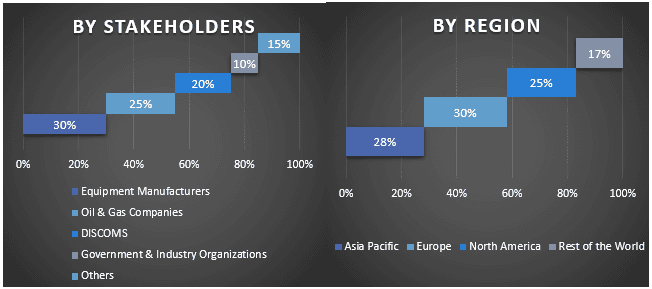
Market Engineering
The data triangulation technique was employed to complete the overall market estimation and to arrive at precise statistical numbers for each segment and sub-segment of the global oil & gas accumulator market. Data was split into several segments & sub-segments post studying various parameters and trends in the areas of type, location of deployment, and application in the global oil & gas accumulator market.
The main objective of the Global Oil & Gas Accumulator Market Study
The current & future market trends of the global oil & gas accumulator market were pinpointed in the study. Investors can gain strategic insights to base their discretion for investments on the qualitative and quantitative analysis performed in the study. Current and future market trends determined the overall attractiveness of the market at a regional level, providing a platform for the industrial participant to exploit the untapped market to benefit from a first-mover advantage. Other quantitative goals of the studies include:
- Analyze the current and forecast market size of the oil & gas accumulator market in terms of value (USD). Also, analyze the current and forecast market size of different segments and sub-segments
- Segments in the study include areas of type, location of deployment, and application.
- Define and analysis of the regulatory framework for the oil & gas accumulator
- Analyze the value chain involved with the presence of various intermediaries, along with analyzing customer and competitor behaviors of the industry.
- Analyze the current and forecast market size of the oil & gas accumulator market for the major region.
- Major countries of regions studied in the report include Asia Pacific, Europe, North America, and the Rest of the World.
- Company profiles of the oil & gas accumulator market and the growth strategies adopted by the market players to sustain in the fast-growing market
- Deep dive regional level analysis of the industry
Related Reports
Customers who bought this item also bought

